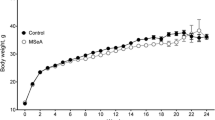Abstract
Evidence for interactive effects of chromium and selenium on the appearance of mammary tumors was obtained by exposing female virgin C3H mice infected with the murine mammary tumorvirus (MMTV) to subtoxic levels of Cr [as Cr(III) nitrate] and Se (as sodium selenite) in the supply water. Cr counteracted the inhibitory effect of Se on tumor development in a dose-dependent manner, shortened the tumor latency period, and accelerated tumor growth rates. Exposure to Cr also altered the levels of Se in the liver and kidneys of the mice, indicating that Cr interacts with Se and affects its organ distribution. Chromium must be added to the list of Se-antagonistic elements that weaken or abolish the antitumorigenic effects of Se. These findings are relevant to human cancer as previous studies revealed the age-corrected mortalities from breast and other major forms of cancer in different countries to be inversely correlated with the dietary Se intakes, and directly correlated with the estimated intakes of Cr and of other Se-antagonistic elements. The presence of these elements in foods must be taken into account when estimating the optimal dose of supplemental Se for cancer risk reduction.
Similar content being viewed by others
References
G. N. Schrauzer, D. A. White, and C. J. Schneider, Cancer mortality correlation studies. III. Statistical associations with dietary selenium intakes, Bioinorg. Chem. 7, 23–34 (1977).
G. N. Schrauzer, D. A. White, and C. J. Schneider, Cancer mortality correlation studies. IV. Associations with dietary intakes and blood levels of certain trace elements, notably Se-antagonists, Bioinorg. Chem. 7, 35–56 (1977).
D. H. Moore, C. A. Long, A. B. Vaidya, J. B. Sheffield, A. S. Dion, and E. Y. Lasfargues, Mammary tumor viruses, Adv. Cancer Res. 19, 347–415 (1979).
Y. Wang, J. F. Holland, I. J. Bleiweiss, et al., Detection of mammary tumor virus ENV gene-like sequences in human breast cancer, Cancer Res. 55, 5173–5179 (1995).
G. N. Schrauzer and D. Ishmael, Effects of selenium and arsenic on the genesis of spontaneous mammary tumors in inbred female C3H mice, Ann. Clin. Lab. Sci. 4, 441–447 (1974).
D. Medina and F. Shepherd, Selenium-mediated inhibition of mouse mammary tumori-genesis, Cancer Lett. 8, 241–245 (1980).
G. N. Schrauzer, Anticacinogenic effects of selenium, CMLS (Cellular and Molecular Life Sciences) 57, 1864–1873 (2000).
W. Mertz, Chromium in human nutrition. A review, J. Nutr. 123, 626–630 (1993).
M. Kanisawa and H. A. Schroeder, Life-term studies on the effect of trace elements on spontaneous tumors in mice and rats, Cancer Res. 29, 992–895 (1969).
O. E. Olson, Fluorimetric analysis of selenium in plants, J. Assoc. Anal. Chem. 52, 627–634 (1969).
G. N. Schrauzer, D. A. White, and C. J. Schneider, Inhibition of the genesis of spontaneous mammary tumors in C3H mice: effects of selenium and of selenium-antagonistic elements and their possible role in human breast cancer, Bioinorg. Chem. 6, 265–270 (1976).
R. Callahan and G. H. Smith, MMTV-induced mammary tumorigenesis: gene discovery, progression to malignancy and cellular pathways, Oncogene 19, 992–1001 (2000).
M. Faedo, C. E. Ford, R. Mehta, K. Blazek, and W. D. Rawlinson, Mouse mammary tumor-like virus is associated with p53 nuclear accumulation and progesterone receptor positivity but not estrogen positivity in human female breast cancer, Clin. Cancer Res. 10, 4417–4419 (2004).
M. A. Beck, P. C. Kolbeck, L. H. Rohr, Q. Shi, V. Morris, and O. A. Levander, Benign human enterovirus becomes virulent in selenium-deficient micem, J. Med. Virol. 43, 166–170 (1994).
E. W. Taylor, R. G. Nadimpalli, and C. S. Ramanathan, Genomic structures of viral agents in relation to the biosynthesis of selenoproteins, Biol. Trace Elem. Res. 56, 63–91 (1997).
J. E. Spallholz, On the nature of selenium toxicity and carcinostatic activity, Free Radical Biol. Med. 17, 45–64 (1994).
B. J. Clodfelder, C. Chang, and J. B. Vincent, Absorption of the biomimetic chromium cation triaqua-3-oxo-μ-hexapropionatotrichromium (III) in rats, Biol. Trace Elem. Res. 97, 1–11 (2004) and references cited therein.
M. Czauderna and M. Rochalska, Interaction between selenium and chromium and distribution of zinc, rubidium, cobalt and iron in mice given chromate ions and selenium compounds, J. Radional. Nucl. Chem. 134, 383–392 (1989).
G. N. Schrauzer, K. P. Shrestha, Y. B. Molenaar, and S. Mead, Effects of chromium supplementation on food energy utilization and the trace element composition of the liver and the heart of glucose-exposed young mice, Biol. Trace Elem. Res. 9, 79–87 (1986).
J. Gromadzin'ska, W. Wasowicz, M. Sklodowska, W. Bulikowski, and K. Rydzyn'ski, The influence of atmospheric chromium on selenium content and glutathione peroxidase activity in blood of tannery workers, Environ. Health Perspect. 104, 1312–1316. (1996).
V. Singh and A. N. Garg, Trace element correlatons in the blood of Indian women with breast cancer, Biol. Trace Elem. Res. 64, 237–245 (1998).
G. Drasch, J. Schoepfer, and G. N. Schrauzer, Selenium/cadmium ratios in human prostates. Indicators of prostate cancer risk of smokers and nonsmokers and relevance to the cancer protective effects of selenium, Biol. Trace Elem. Res. 103, 103–107 (2005).
Author information
Authors and Affiliations
Rights and permissions
About this article
Cite this article
Schrauzer, G.N. Interactive effects of selenium and chromium on mammary tumor development and growth in MMTV-infected female mice and their relevance to human cancer. Biol Trace Elem Res 109, 281–292 (2006). https://doi.org/10.1385/BTER:109:3:281
Received:
Accepted:
Issue Date:
DOI: https://doi.org/10.1385/BTER:109:3:281




